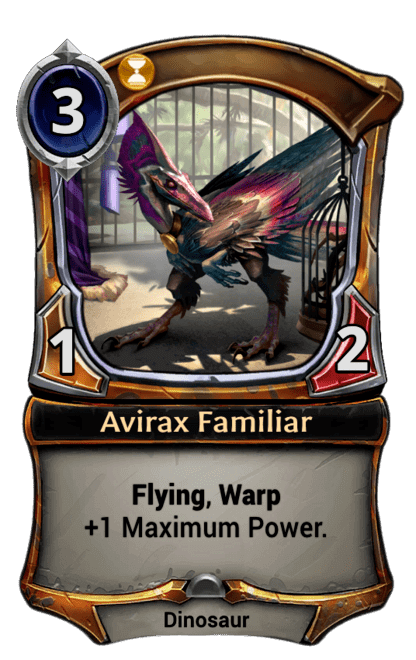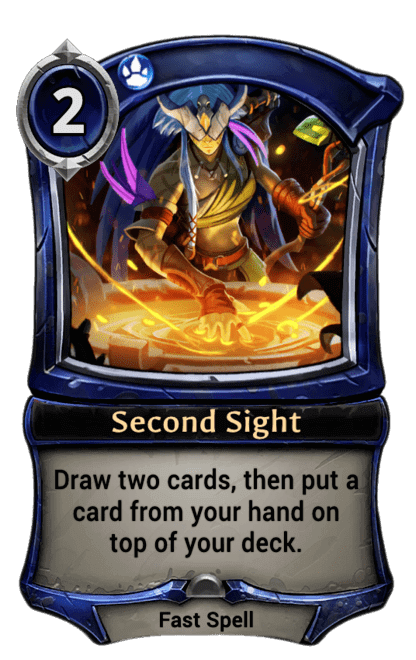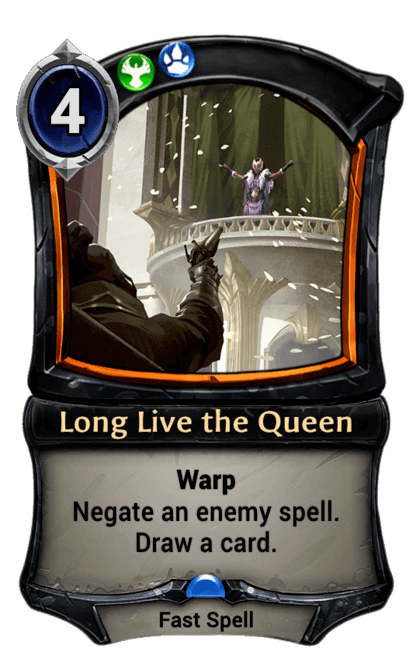

Back in July, I gave a comparative introduction to Eternal Card Game, and a very high-level analysis. I've been playing the game compulsively since then, even to the exclusion of Magic Online and Arena, which feel frankly prehistoric to me now. I have a ton of deeper thoughts about Eternal, so I'm going to start sharing them with you.
Let's start with one of my least favorite mechanics: Warp.
You can play a card with warp while it's on top of your deck. That works exactly as you'd expect: A warp card is visible (and a bit glowy) while on top of your deck; If you do play it, it does its thing and your deck is now one card smaller, with a new top; If you don't, you draw it the next time you'd draw a card. The former feels good, as it's pure card advantage; the latter feels awful because you missed out on the great thing and you're stuck drawing the card you couldn't play last time.
Card advantage mechanics are dangerous, which is why they tend to be risky or conditional. Magic hasn't keyworded many, for good reason.
 Let's rephrase this mechanic to get another perspective on it: "If you cast this card the turn you draw it, draw a card." That's functionally identical, except time-shifted back one turn. This mechanic is clearly asking us to be flexible and do what it wants when it wants us to, rather than whatever we were going to do that turn. It rewards adaptability and implicitly reduces player choice; but the reward of a whole card is huge, so it's worth it. Right?
Let's rephrase this mechanic to get another perspective on it: "If you cast this card the turn you draw it, draw a card." That's functionally identical, except time-shifted back one turn. This mechanic is clearly asking us to be flexible and do what it wants when it wants us to, rather than whatever we were going to do that turn. It rewards adaptability and implicitly reduces player choice; but the reward of a whole card is huge, so it's worth it. Right?In Magic, the mana value of a random card is 2. There's less direct evidence it's the same in Eternal, but as a game very closely modeled after Magic, it's safe to say it is. A mechanic that guarantees you draw an extra card when you play the spell—a cantrip—adds 2 to the cost of a card. Warp sometimes does this, and so must increase a card's cost >0 and <2; approximately (but not necessarily exactly) 1. You pay this premium whether the card warps successfully or not. That's another factor that makes a failed warp feel worse, but we can also evaluate it rationally: If the warp version of a card costs exactly 1 more than the non-warp version (blinkwolf vs drifter), and the mana-value of a successful warp is 2, then the gamble is positive EV (expected value) if we are more than 50% likely to warp that card.
 When you draw a warp card in your opening hand, you're sad because you won't get the chance to warp that card even though you're still paying the mana premium for it. It's your first or second turn of the game, and you draw Avirax Familiar, you're still sad because you don't have enough power to cast it. This is doubly frustrating when you're stuck on two power and are hoping to draw a power card; you see this thing that should help you get back on curve, but because of the circumstances is actually holding you back. If it's your third turn, you slam it down with a grin. On later turns, you might be happy to warp it in; or it might conflict with what you really wanted to play that turn; or it might just be no longer relevant, in which case warp is effectively letting you cycle it.
When you draw a warp card in your opening hand, you're sad because you won't get the chance to warp that card even though you're still paying the mana premium for it. It's your first or second turn of the game, and you draw Avirax Familiar, you're still sad because you don't have enough power to cast it. This is doubly frustrating when you're stuck on two power and are hoping to draw a power card; you see this thing that should help you get back on curve, but because of the circumstances is actually holding you back. If it's your third turn, you slam it down with a grin. On later turns, you might be happy to warp it in; or it might conflict with what you really wanted to play that turn; or it might just be no longer relevant, in which case warp is effectively letting you cycle it.So how often were we happy to be playing our Familiar (over say, Initiate of the Sands or Auralian Merchant)? The first 9 draws of our game are bad. The 10th is great. And the remainder are context-dependent, getting bad again quickly but leveling off as decent the longer the game goes. But how long does a game of Eternal go? I have no stats for this—despite Eternal having more data than Magic, they are much less transparent in all things—but a really aggro run-over takes 5-6 turns and all but the durdliest of slogs are done before turn 15. I'd say 9 or 10 turns is the likely average game length. If I draw 17 cards in that time, I can successfully warp my Familiar at most 8 times, and I'll probably only be happy about it 6, tops. 6/10 is the minimum success rate to make the gamble worthwhile (and that's assuming warp only added +1 cost to Familiar, which is debatable), so I'm really only happy in the best case.

In fairness, that's the best case for a deck of unknown makeup and strategy. You can increase your EV by adding scry effects or using cards like Second Sight to put warp cards you've drawn back on top of your deck. Accelerating your power lets you reach the threshold to play your warp cards sooner, as well as letting you cast multiple cards later. You'll notice that Avirax helps with that. In fact, one of the best strategies to make use of a few warp cards… is to play a ton of warp cards; The more often you warp, the more you're drawing, the more power you're playing, and the more often you can warp. On the other hand, your whole deck costs 1 more, so you're a full turn behind your opponent regardless of whose playing what tap-lands. If you're {R}{W}, you run Workshop Forge to negate that, of course.
Expensive warp cards like Plated Goliath are even harder to successfully warp, but generally have a lower premium. All of the rarer cards are expensive so they can ignore the premium entirely and just be splashy out-of-nowhere. The best cards are legendary—as the F2P model necessitates—but the best warp cards otherwise are the ones that grant warp to a bunch of non-warp cards in your deck: Waystone Infuser, Waker of Ancients, and Clever Stranger.
If I could test one change to warp, it would be that you can't draw a card with warp; If you would (presumably because you couldn't cast it the turn prior), it goes to the bottom of your deck instead. I'm skeptical that'd stick because it makes them all much stronger—and will occasionally frustrate players who did want that card, just not that turn—but if it does work, it'd be great.
If I could test two changes, the next would be to push the added cost off, so that you're only paying extra when you actually warp it. Or when you're hard-casting it. That's my concern with this solution; the former exacerbates the difficulty of actually warping a card (but at least eliminating much of the feel bad of drawing one), while the latter makes warping easier and more reliable (which is dangerous) at the expense of making it feel even worse when you don't.
The solution I'm most confident would improve gameplay is to give the player the option of bottoming a warp card when they draw it, but that's slower, thinkier, and clickier than automatically doing so.
 Despite my concerns with warp, it's got a lot going for it. Check out Long Live the Queen: It's 'just' a Scatter Arc in your hand, but when you do cast it from your deck, it's a 2-for-0. It's true that you have to work to make warp good enough, but one of my very favorite characteristics of Eternal is the way the everything is built to combo with a ton of other things, and mostly at fairly fundamental levels: That makes doing the work to make warp awesome, fun.
Despite my concerns with warp, it's got a lot going for it. Check out Long Live the Queen: It's 'just' a Scatter Arc in your hand, but when you do cast it from your deck, it's a 2-for-0. It's true that you have to work to make warp good enough, but one of my very favorite characteristics of Eternal is the way the everything is built to combo with a ton of other things, and mostly at fairly fundamental levels: That makes doing the work to make warp awesome, fun.


It's hard to decide how I feel about your first change, because obviously warp cards would look totally different if you couldn't draw them, but at the moment, the warp cards the actually get played are the ones that are a good deal even from your hand, and the last thing I'd want is not to be able to draw my Hearts of the Vault.
ReplyDeleteI'm not sure the best way to balance a really swingy mechanic is to print cards that are so good even the worst case feels borderline unfair, but that seems to be their current strategy.
DeleteNot being able to draw warp cards functionally decreases the size of your deck. Want to play with a 50 card deck? just jam 20 warp cards in. That seems super susceptible to abuse.
DeleteWarp cards that you can't play off the top are the nut worst. I still think there should be some added cost for the flexibility (otherwise you'd never play the base version of the card), but I like your change of making them cheaper to hardcast than to warp. Right now it feels like if you fail to warp, your deck is mocking you with a dead draw next turn, so making the draw less dead would be an improvement. Incidentally this isn't the case for effects like miracle (another stupidly swingy mechanic) that are supposed to be a pleasant surprise.
ReplyDeleteDid you know there's a secret achievement for warping eight units in a single turn? (They MUST come off the top, and they MUST be units, so no cheating with Waystone Infuser or Brilliant Discovery, i.e. cards that would actually help you hit your warp cards on-curve.) I have to wonder what kind of masochistic dev actually pulled off that one.
The Praxis stranger is probably involved here.
DeleteI wonder if there are other "random cantrip" designs out there. Red's impulse draw often has that effect, although the fact that say Abbot exiles the card helps reduce the feel bad impulse. Needing the extra mana also really reduces the kinds of designs you can put it on. There's also Explore, which is a conditional cantrip that gives you a potential draw or a minor upside. One potential help for warp would be something similar:
ReplyDeletePraw (You may play this card from the top of your deck. If you draw this card, it gets +1/+1.)
I'd love to get playtest data on Praw. It might feel bad both ways because you never get it all, or it might help a ton. It only helps with units which leads to…
DeletePawr (You may play this card from the top of your deck. If you draw this card, it costs 1 less.)
I guess that's option 2b from the post, but writing it out feels pretty good.
I like both, although I'd worry that 2b would be more of a development challenge because it negates the natural balancing mechanic of warp cards costing more. Or it gets baked in and now those cards cost 2 more normally instead of 1. The +1/+1 solution doesn't fit on spells, which is unfortunate, but it does put those cards on a more consistent curve which helps their balance.
Delete